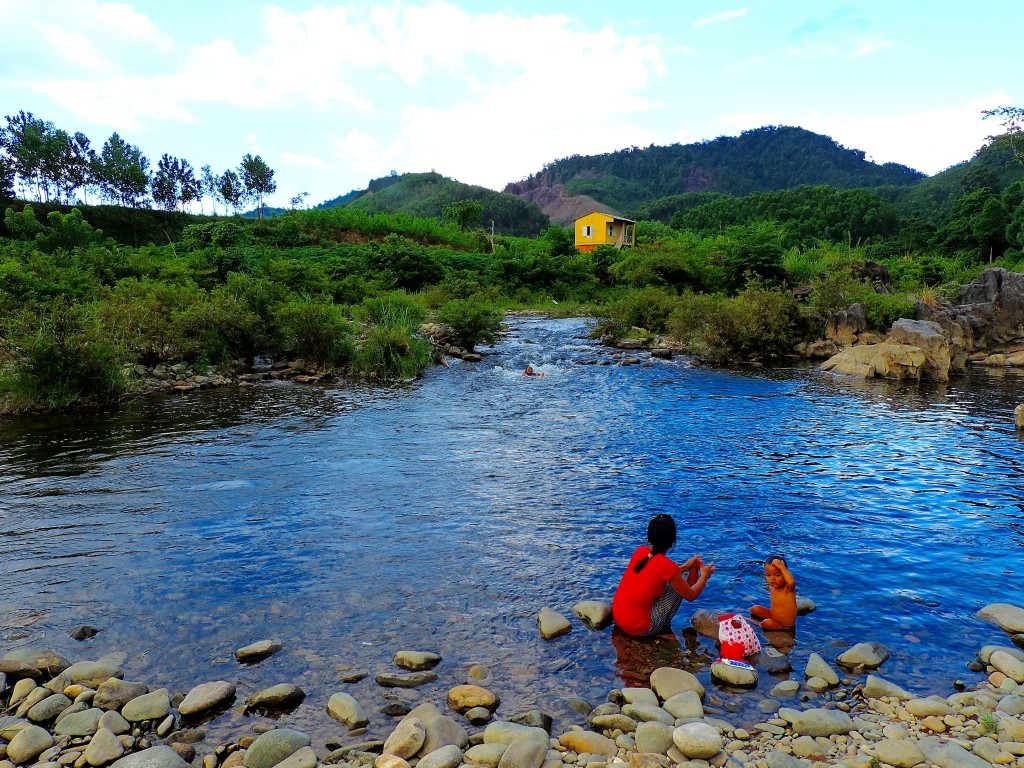By Anna Panariello, M.S. in Environmental Policy 2016
The backpacks are ready: hiking boots, a few long-sleeved shirts, a pair of quick-drying hiking pants, and many wool socks to soften the bruises that the road gives you.
“You will feel parts of your body you never thought you had before”, I’d repeated to myself while I was going through security at the airport in Hanoi. And yes, I did discover them all!
What a sacred feeling is the lightness of being; that, by the way, has nothing to do with frivolity. All that I had considered significant until that moment had suddenly disappeared before my eyes.
What was essential was inside of us; all I needed was my body.
The roots I’d spent my life cultivating were slowly releasing and I realized I was ready to plant them somewhere else.
So it was that, while the light of dawn on our skin was preparing us for the beauty of the world, on the road to Bach Ma National Park in Central Vietnam, I planted my first root.

But let’s start from the beginning.
From New York City to…

As part of my graduate school qualifications at Bard Center for Environmental Policy, I am having the incredible opportunity to intern at the American Museum of Natural History’s Center for Biodiversity and Conservation (AMNH-CBC) in New York City. The CBC works to transform diverse sources of knowledge into actions that conserve biological and cultural diversity, interfacing with partners from around the world on these matters.
…Vietnam
In particular, CBC’s researchers have been interested in the fascinating land of Vietnam thanks to its rich biodiversity, especially of primate species—Vietnam has the largest number of primate species in Southeast Asia.
In 1995 the U.S and Vietnam formally normalized relations and began working together.
Since 1996, year of the first CBC expedition, many other years of fieldwork have brought a number of discoveries and a heritage of scientific partnerships that endures until the present day.
The Project
As an economist by training, I joined the team at CBC during the final expedition of its latest project in Vietnam. The project, created in 2012, studies an elusive, nocturnal, large-eyed primate: the slow loris (Nycticebus).
All primate species are protected by law in Vietnam, but due to ongoing forest loss and weak enforcement of laws against illegal hunting, the majority of primate species in Vietnam are now threatened with extinction.
To address this issue, CBC Assistant Director for Research and Strategic Planning Mary Blair in collaboration with the partners at the Centre for Natural Resources and Environmental Studies (CRES) at Vietnam National University in Hanoi, and Gautam Sethi, Professor of Economics at Bard CEP has formed a team of biologists, economists, and anthropologists and crafted a unique interdisciplinary approach. The team gathers slow loris population data through night surveys in the forest, and it also interviews local people in order to understand the drivers and the patterns of scale of wildlife trade of lorises.
My First Night in the Field
The first month of our expedition consisted for us of becoming as nocturnal as our target animal. Having lived in cities my whole life, I thought it wouldn’t be a problem for me to adapt to this behavior, but I was made well aware of the fact that the forest “changes” its face from day to night.
My heart pounded with both excitement and fear while I was getting ready to do my first ever night survey in the forest of Bach Ma National park.
I wore, what I would soon discover to be very useful leech socks. I tied them up tight—sure that I didn’t want my first encounter in the forest to be with leeches!
I’d packed my backpack with all the necessaire for the night. I wore my hair in a bun and positioned first my bandana and then the headlamp that would help us see the tapetum lucidum, or eye shine, that would reflect the light of our lamps back through the retina of the lorises in the dark.
I couldn’t resist—I looked myself in the mirror and could barely recognize myself.

The protocol
Of course, we needed to be prepared for everything. That’s why every day we carefully followed “the protocol.”
The protocol calls for the team to go to the survey site during the day to familiarize ourselves with it, make notes on the type of forest, and make sure there is an existing trail (otherwise we needed to cut a new one).
Around 7 p.m., right before it turned dark, the team reached the preset site by motorcycles. The road was the same we travelled during the day, but the visibility had changed. The rocks surrounding it appeared bigger, and it seemed as though we were traveling a completely different path.
It was pitch black! We couldn’t see each other unless we used a mini maglite, it took awhile for our eyes to adjust to the dark. At that point, with our equipment ready, we split into two teams of three persons each in order to survey different parts of the forest.
After having taken all the necessary measurements—temperature, moonlight and starting waypoints—the two teams were ready to enter the forest and look for lorises.
As I walked in, I felt a myriad of eyes looking right at me. “Will it be me who sees the first loris?” I kept thinking.
We proceeded, walking methodically in straight lines, our heads slowly turning in a zig-zag motion from left to right, in order to make sure we did not miss any spots.
“How many lorises have you seen?”
Unfortunately, our night surveys have not been successful on this trip—we have not seen any lorises in the wild. Lorises are extremely rare to begin with; on average, our teams only see one loris for every 4 kilometers. And, with hunting pressure, the likelihood of seeing one diminishes even more.
However, something strange and touching happened at the end of every night survey.
Sweaty, thirsty and hungry I would raise my eyes to the sky, and there I saw it: the magnificence of a starry night. I could barely hold back my tears and a voice inside of me whispered: “I’d do it a thousands more times only to be rewarded with the beauty I have the chance to witness every night.”
What’s next?
My two months in Vietnam are coming to a close. In a week I will return to my original continent where my roots came from. As I write these last few lines, though, my heart is pounding with the awareness that my time in Vietnam has been truly invaluable.
I am looking forward to returning to the concrete jungle of New York City this fall to put into practice what I am learning during my time in the forest and the skills I gained during my first year at Bard CEP, and to keep working alongside such inspiring people.

“But if a man be alone, let him look at the stars. The rays that come from those heavenly worlds, will separate between him and vulgar things. One might think the atmosphere was made transparent with this design, to give man, in the heavenly bodies, the perpetual presence of the sublime.” ~Ralph Waldo Emerson
Sounds like an absolutely wonderful experience. Unfortunate that you didn’t see a slow loris in the wild, but it just means your internship and the cause are even more important!
I love this quote, thank you for sharing Karen!
Hopefully I will see you in a week of so.